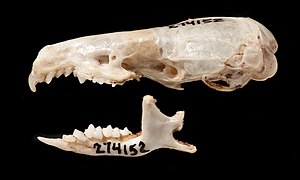Eyelash shrew
| Eyelash shrew | ||||||||||||
|---|---|---|---|---|---|---|---|---|---|---|---|---|

skull |
||||||||||||
| Systematics | ||||||||||||
|
||||||||||||
| Scientific name | ||||||||||||
| Crocidura attenuata | ||||||||||||
| Milne-Edwards , 1872 |
The eyelash shrew ( Crocidura attenuata ) is a species of shrew from the genus of the white-toothed shrew ( Crocidura ). It occurs in large parts of East and Southeast Asia.
features
With a head-torso length of 6.6 to 8.9 centimeters and a weight of about 6 to 12 grams, the eyelash shrew is one of the medium-sized shrews. The tail reaches a length of 41 to 60 millimeters and generally corresponds to 60 to 70% of the head-trunk length. The hind foot reaches a length of 13 to 16 millimeters and the ear 7 to 13 millimeters. The back fur is smoky brown to dark gray-black, on the belly side the color changes gradually to a dark gray. The summer fur is a little darker than the winter fur. The tail is dark brown on the top and a little lighter on the underside, but not clearly contrasted.
| 1 | · | 3 | · | 1 | · | 3 | = 28 |
| 1 | · | 1 | · | 1 | · | 3 |
The skull has a total length of 19 to 22 millimeters. Like all species of the genus, the species has one incisor per half in the upper jaw and then three single-pointed teeth, a premolar and three molars . In the lower jaw, however, it has a single canine behind the incisor. In total, the animals have a set of 28 teeth. As with all white-toothed shrews, the tooth roots are not pigmented in contrast to those of the red- toothed shrews.
The genome of the eyelash shrew was examined in both the island population in Taiwan and indigenous people from mainland China. It was found that the diploid chromosome set on the Chinese mainland consists of 2n = 35–38 (FN = 54) compared to 2n = 40 (FN = 56) on Taiwan. On this basis, the Taiwanese form was raised to the species status of Crocidura tanakae .
distribution

The eyelash shrew occurs in large parts of East and Southeast Asia. The distribution area extends from India and probably Pakistan over a large area of the People's Republic of China to the Malay Peninsula and the offshore islands. In addition to the states mentioned, it also occurs in Cambodia , Laos , Malaysia , Thailand , Myanmar , Vietnam and the Philippines .
In the Philippines, it was assumed that the species only occurs on Batan , but in 2004 it was also found on Calayan Island and the Babuyan Islands as part of a survey . It is unclear whether the species also occurs in Sumatra , Indonesia . In China, the species occurs in the provinces of Jiangsu , Zhejiang , Anhui , Jiangxi , Hubei , Hunan , Sichuan , Yunnan , Guangdong , Guanxi , Gansu , Fujian and Guizhou as well as on Hainan . The populations of the island of Taiwan, on the other hand, are regarded as a separate species. The altitude distribution is probably up to 3000 meters.
Way of life
Within their range, the eyelash shrew is usually the most common shrew and their way of life is typical of shrews. It lives in numerous, different habitats such as coniferous, deciduous, mixed and bamboo forests and in shrub vegetation on the ground. Like all shrews, this species feeds on invertebrates, mostly insects and worms. Little is known about reproduction; litter sizes of four to five young animals have been documented.
Systematics
The eyelash shrew is classified as an independent species within the genus of the white-toothed shrew ( Crocidura ), which consists of around 170 species. The first scientific description comes from Henri Milne-Edwards from 1872, who described an individual from the province of Sichuan . C. tanakae was partially classified as a subspecies in this species, but has since been separated out due to a significantly different genome and viewed as an independent species. The same applies to the Christmas Island shrew ( Crocidura trichura ).
Today, apart from the nominate form Crocidura attenuata attenuata, no further subspecies are distinguished within the species .
Threat and protection
The eyelash shrew is classified by the International Union for Conservation of Nature and Natural Resources (IUCN) as least concern due to its very large distribution area, the assumed large populations and the non-existent threat to the population. In addition, the species occurs in numerous protected areas within its range. Potential threats to the populations are not known; regionally, there may be a threat from habitat loss or competition with introduced species ( neozoa ).
literature
- Robert S. Hoffmann, Darrin Lunde: Asian Gray Shrew. In: Andrew T. Smith , Yan Xie: A Guide to the Mammals of China. Princeton University Press, Princeton NJ 2008, ISBN 978-0-691-09984-2 , p. 298.
Web links
- Crocidura attenuata inthe IUCN 2013 Red List of Threatened Species . Listed by: L. Heaney, S. Molur, 2008. Retrieved January 14, 2014.
supporting documents
- ↑ a b c d e f Robert S. Hoffmann, Darrin Lunde: Asian Gray Shrew. In: Andrew T. Smith , Yan Xie: A Guide to the Mammals of China. Princeton University Press, Princeton NJ 2008, ISBN 978-0-691-09984-2 , p. 298.
- ↑ a b c d e f Crocidura attenuata ( Memento from January 16, 2014 in the Internet Archive ). In: Don E. Wilson , DeeAnn M. Reeder (Eds.): Mammal Species of the World. A taxonomic and geographic Reference. 2 volumes. 3. Edition. Johns Hopkins University Press, Baltimore MD 2005, ISBN 0-8018-8221-4 .
- ↑ a b c Crocidura attenuata in the Red List of Threatened Species of the IUCN 2013.2. Listed by: L. Heaney, S. Molur, 2008. Retrieved January 14, 2014.